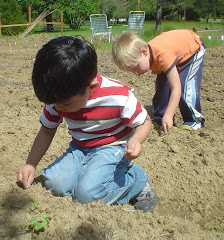 |
| Kale - a generous plant! |
In recent weeks we've seen several headlines announcing that kale has
made it onto the "Dirty Dozen" list for the first time in
ten years. The "Dirty Dozen" list is compiled each year by testing thousands of samples of fruits and vegetables from different sources to
see which have highest concentrations of herbicides and pesticides
LINK.
And the farm chemicals are not just showing up on the vegetables
themselves, studies have shown that, people being tested have
increasingly been found to have these chemicals show up in fluid samples
such as blood and urine (see links below). It is unfortunate that kale has returned
to the "Dirty Dozen" list as, in the past few years, it has shown a surge in
popularity. Its recent following is not surprising as it tastes similar to
broccoli (
a favorite on American plates)
and it is at the top of another, more favorable list - The Aggregate Nutrient Density Index (ANDI), that rates foods by
their nutrient density.
Kale has the densest concentration of nutrients, per calorie, of a wide range of foods tested. (
PDF of 72 tested foods) (
explanation of chart).
On the positive side of things,
people who have switched to an all-organic diet have been able to reduce
these chemical residues in their bodies by as much as 90% in as little as two weeks
LINK.
So, if you'd like to incorporate more organically grown kale into your diet and you're on a budget (we've noticed that prices for organic kale have really risen in the past few years...)
perhaps you'd like to try and grow your own!
Grow your own kale: Kale is super-easy to grow and 2-4 plants
will easily keep a family fed over the course of the summer. If your
climate isn't too harsh you can grow a second crop that will produce
food through the fall and winter too (though at a much slower rate).
Here's our POST on growing kale.
 |
| Our CSA provides delicious, nutritious food May to November. |
Or, if you live in our area, you can join our CSA and receive a large box of delicious organic produce on a weekly basis - including copious amounts of green-leafy vegetables. We still have some CSA "shares" to offer. Over six-months of vegetables
and fruits for $700. More info
HERE.
How we grow our food at the Sharing Gardens: Because we are not a
commercial farm, all our labor is provided by volunteers and we are
under no pressure to produce food on a forced timeline to get it to
market ahead of the other farmers in our area, our food is slow-grown,
with less water-weight and hence more nutrient-dense. We fertilize
primarily with compost derived from leaves, grass, weeds and food
scraps, wood-ash from our wood-burning stove and with worm castings we
harvest from the paths of our greenhouses LINK. We do not use
commercial fertilizers. The wood-ash and the composted tree-leaves both
provide re-mineralization of our soils because the tree-roots pull up
minerals from deep within the soil. Without forcing our plants to grow
fast with high-nitrogen fertilizers, or animal manures, they are
more resistant to diseases and insect infestations that are caused, in
part, by the thinner cell-walls of plants forced to grow unnaturally
quickly.
Or, if you live in our area and would like to
eat the kale we donate to
Monroe's Food Pantry, you can shop weekly for free at the
South Benton Food Pantry (some income-criteria required).
 |
| Sign posted at the Food Pantry to encourage more kale-eating. |
Related links:
Kale rejoins the list of Dirty-Dozen list as one of the most contaminated with pesticides:
Not-So-Superfood! Pesticide residue found in 70% of U.S. produce & 92% of kale
What the pesticides in our urine tell us about organic food - The Guardian
Organic diet intervention significantly reduces urinary pesticide levels in U.S. children and adults - Science Direct
 |
| Now, doesn't that look yummy! |











































No comments:
Post a Comment